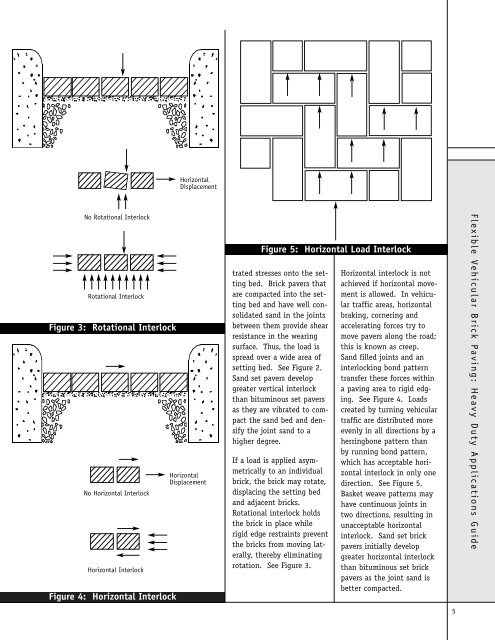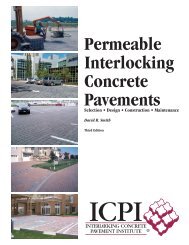Create successful ePaper yourself
Turn your PDF publications into a flip-book with our unique Google optimized e-Paper software.
No Rotational Interlock<br />
Rotational Interlock<br />
Figure 3: Rotational Interlock<br />
No Horizontal Interlock<br />
Horizontal Interlock<br />
Figure 4: Horizontal Interlock<br />
Horizontal<br />
Displacement<br />
Horizontal<br />
Displacement<br />
Figure 5: Horizontal Load Interlock<br />
trated stresses onto the setting<br />
bed. <strong>Brick</strong> pavers that<br />
are compacted into the setting<br />
bed and have well consolidated<br />
sand in the joints<br />
between them provide shear<br />
resistance in the wearing<br />
surface. Thus, the load is<br />
spread over a wide area of<br />
setting bed. See Figure 2.<br />
Sand set pavers develop<br />
greater vertical interlock<br />
than bituminous set pavers<br />
as they are vibrated to compact<br />
the sand bed and densify<br />
the joint sand to a<br />
higher degree.<br />
If a load is applied asymmetrically<br />
to an individual<br />
brick, the brick may rotate,<br />
displacing the setting bed<br />
and adjacent bricks.<br />
Rotational interlock holds<br />
the brick in place while<br />
rigid edge restraints prevent<br />
the bricks from moving laterally,<br />
thereby eliminating<br />
rotation. See Figure 3.<br />
Horizontal interlock is not<br />
achieved if horizontal movement<br />
is allowed. In vehicular<br />
traffic areas, horizontal<br />
braking, cornering and<br />
accelerating forces try to<br />
move pavers along the road;<br />
this is known as creep.<br />
Sand filled joints and an<br />
interlocking bond pattern<br />
transfer these forces within<br />
a paving area to rigid edging.<br />
See Figure 4. Loads<br />
created by turning vehicular<br />
traffic are distributed more<br />
evenly in all directions by a<br />
herringbone pattern than<br />
by running bond pattern,<br />
which has acceptable horizontal<br />
interlock in only one<br />
direction. See Figure 5.<br />
Basket weave patterns may<br />
have continuous joints in<br />
two directions, resulting in<br />
unacceptable horizontal<br />
interlock. Sand set brick<br />
pavers initially develop<br />
greater horizontal interlock<br />
than bituminous set brick<br />
pavers as the joint sand is<br />
better compacted.<br />
5<br />
<strong>Flexible</strong> <strong>Vehicular</strong> <strong>Brick</strong> <strong>Paving</strong>: Heavy Duty Applications Guide



